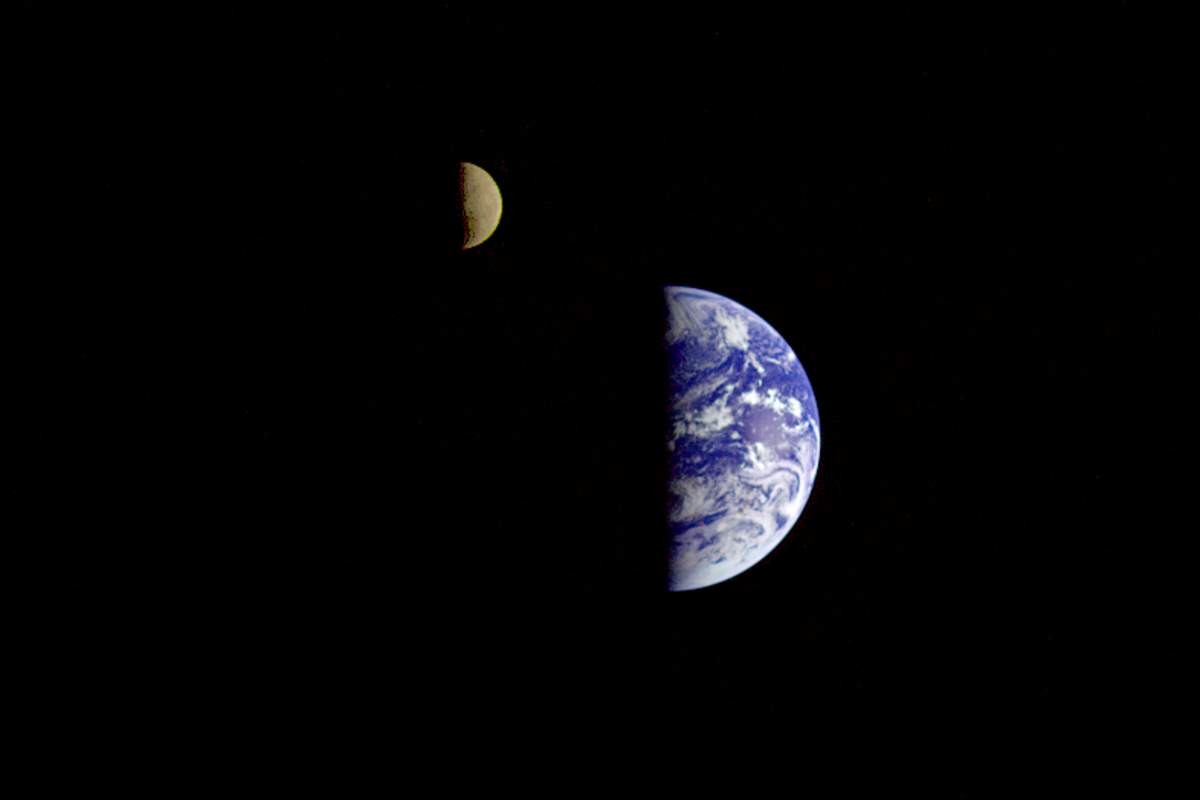NASA’s Galileo spacecraft was launched on October 18, 1989, with the mission of studying Jupiter and its moons. It orbited Jupiter for almost eight years and made close passes by all its major moons. By doing so, it became the first spacecraft to orbit an outer planet in our solar system. Galileo also studied two asteroids, Gaspra and Ida, and discovered the first moon orbiting an asteroid (Dactyl orbiting Ida).
Today’s (October 18) story of what happened this day in Science, Technology, Astronomy, and Space Exploration history.
Galileo spacecraft
Built by NASA’s Jet Propulsion Laboratory, Galileo spacecraft was launched on October 18, 1989 with Space Shuttle Atlantis (STS 34). The shuttle went into a 343 kilometers (213 miles) orbit and deployed Galileo which consists of actually two spacecraft: an orbiter and an atmospheric probe.
The launch was perfect, and Galileo was soon headed towards Venus for gravitational assist at over 14,000 km/h (9,000 mph). Atlantis returned to Earth safely on October 23.
Galileo performed the Venus slingshot maneuver on February 10, 1990. After getting a speed boost from Venus, the spacecraft also gravitionally assisted by Earth twice: on December 8, 1990, and December 8, 1992. Then it headed toward the outer solar system.
While en route to Jupiter, Galileo also discovered the first asteroid with a moon: On August 28, 1993, it obtained an extensive data set on 243 Ida, a small member of the Koronis family of the asteroid belt.
Most of the data recorded on the tape recorder returned to Earth in the spring of 1994. The data set has yielded an unprecedentedly high-resolution portrait of 243 Ida and its small moon, the first natural satellite discovered orbiting an asteroid, Dactyl.
Galileo also observed comet Shoemaker-Levy 9’s fragments while en route. July 1992. At that time, the orbit of Shoemaker–Levy 9 passed within Jupiter’s Roche limit, and Jupiter’s tidal forces had acted to pull apart the comet. The comet was observed as a series of fragments ranging up to 2 km (1.2 mi) in diameter because Jupiter’s gigantic tidal forces had acted to pull apart the comet. These fragments collided with Jupiter’s southern hemisphere between July 16 and 22, 1994.
Arrival at Jupiter
On December 7, 1995, Galileo finally entered Jupiter’s orbit. The same day it released its atmospheric probe. The probe descended directed into the gas giant’s atmosphere, returning data almost for an hour before it was destroyed by the harsh conditions and huge pressure found at depth.

Europa encounter
On September 7, 1996, during the second orbit around Jupiter, Galileo performed a Europa flyby, one of the planet’s largest four moons.
The mission’s many observations of Europa helped convincing scientists that the intriguing world hides a huge ocean of liquid water beneath its ice shell.

Related: Oceans of the Solar System
Io encounter
On September 19, 1997, during its tenth orbit of Jupiter, the spacecraft made observations of the moon Io and its surface.
Io has the highest density of all the moons, and has the least amount of water of any known astronomical object in the Solar System.

Joint observations with Cassini
On December 30, 2000, the passing Cassini spacecraft en route to Saturn, conducted joint Jupiter observations with Galileo.
Journey’s end
On September 21, 2003, Galileo spacecraft was commanded to plunge into Jupiter’s atmosphere and got deliberately destroyed to protect one of the mission’s own discoveries: a possible ocean beneath the icy crust of Europa. Scientists chose this method to eliminate the probability of Galileo smashing into Europa in future. The probability is really small actually, but scientists just wanted to make sure.
Cassini’s end would be the same: in its Grand Finale, on September 15, 2017, Cassini plunged into Saturn’s atmosphere and disintegrated, returning science data to the very end.
10 Key Scientific Discoveries of the Galileo spacecraft
- The discovery of a satellite (Dactyl) of an asteroid (Ida).
- The existence of a global ocean of liquid water under the icy surface of Jupiter’s moon Europa.
- Galileo magnetic data provide evidence that the moons Ganymede and Callisto also likely have a liquid saltwater layer.
- Ganymede is the first moon known to possess a magnetic field.
- The atmospheric probe discovered that Jupiter has thunderstorms many times larger than Earth’s.
- The probe measured atmospheric elements, and found that their relative abundances were somewhat different than on the Sun, indicating Jupiter’s evolution since the planet formed.
- Io’s extensive volcanic activity may be 100 times greater than that found on Earth. The heat and frequency of eruption are reminiscent of early Earth.
- Io’s complex plasma interactions in Io’s atmosphere include support for currents and coupling to Jupiter’s atmosphere.
- Europa, Ganymede, and Callisto all provide evidence of a thin atmospheric layer known as a “surface-bound exosphere”.
- Jupiter’s ring system is formed by dust kicked up as interplanetary meteoroids smash into the planet’s four small inner moons. The outermost ring is actually two rings, one embedded within the other.
Sources
- Galileo Project Information on the NASA website
- Galileo Mission info on the NASA Jet Propulsion Laboratory website
- Galileo Mission info on the NASA Solar System Exploration website
- Moon Landings: All-Time List [1966-2025] - February 2, 2025
- What Is Max-Q and Why Is It Important During Rocket Launches? - January 16, 2025
- Top 10 Tallest Rockets Ever Launched [2025 Update] - January 16, 2025

